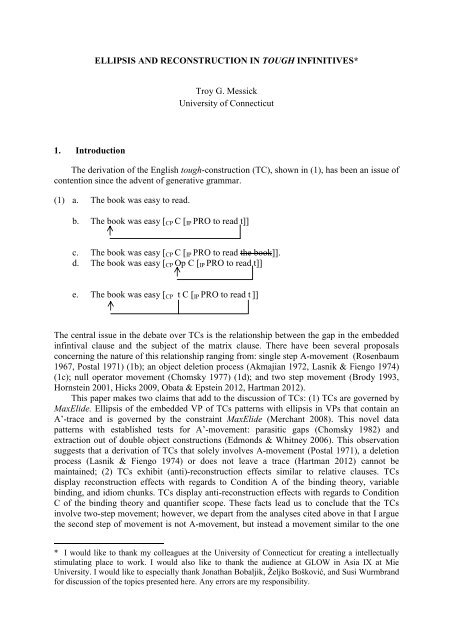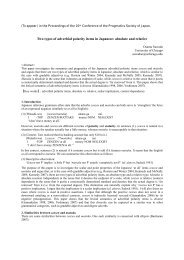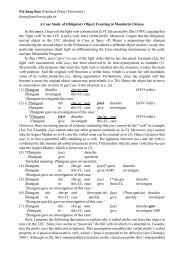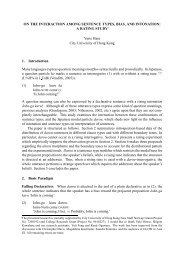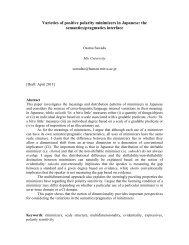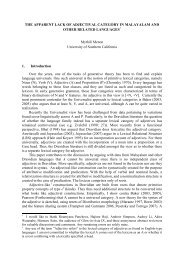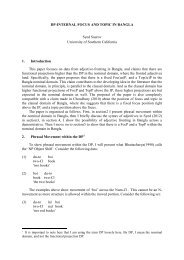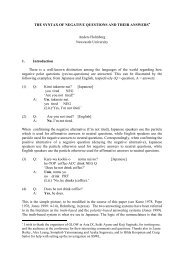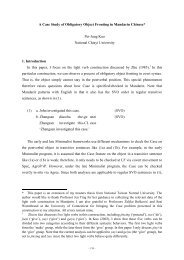ELLIPSIS AND RECONSTRUCTION IN TOUGH INFINITIVES* Troy ...
ELLIPSIS AND RECONSTRUCTION IN TOUGH INFINITIVES* Troy ...
ELLIPSIS AND RECONSTRUCTION IN TOUGH INFINITIVES* Troy ...
You also want an ePaper? Increase the reach of your titles
YUMPU automatically turns print PDFs into web optimized ePapers that Google loves.
<strong>ELLIPSIS</strong> <strong>AND</strong> <strong>RECONSTRUCTION</strong> <strong>IN</strong> <strong>TOUGH</strong> <strong>IN</strong>F<strong>IN</strong>ITIVES*<br />
<strong>Troy</strong> G. Messick<br />
University of Connecticut<br />
1. Introduction<br />
The derivation of the English tough-construction (TC), shown in (1), has been an issue of<br />
contention since the advent of generative grammar.<br />
(1) a. The book was easy to read.<br />
b. The book was easy [ CP C [ IP PRO to read t]]<br />
c. The book was easy [ CP C [ IP PRO to read the book]].<br />
d. The book was easy [ CP Op C [ IP PRO to read t]]<br />
e. The book was easy [ CP t C [ IP PRO to read t ]]<br />
The central issue in the debate over TCs is the relationship between the gap in the embedded<br />
infintival clause and the subject of the matrix clause. There have been several proposals<br />
concerning the nature of this relationship ranging from: single step A-movement (Rosenbaum<br />
1967, Postal 1971) (1b); an object deletion process (Akmajian 1972, Lasnik & Fiengo 1974)<br />
(1c); null operator movement (Chomsky 1977) (1d); and two step movement (Brody 1993,<br />
Hornstein 2001, Hicks 2009, Obata & Epstein 2012, Hartman 2012).<br />
This paper makes two claims that add to the discussion of TCs: (1) TCs are governed by<br />
MaxElide. Ellipsis of the embedded VP of TCs patterns with ellipsis in VPs that contain an<br />
A’-trace and is governed by the constraint MaxElide (Merchant 2008). This novel data<br />
patterns with established tests for A’-movement: parasitic gaps (Chomsky 1982) and<br />
extraction out of double object constructions (Edmonds & Whitney 2006). This observation<br />
suggests that a derivation of TCs that solely involves A-movement (Postal 1971), a deletion<br />
process (Lasnik & Fiengo 1974) or does not leave a trace (Hartman 2012) cannot be<br />
maintained; (2) TCs exhibit (anti)-reconstruction effects similar to relative clauses. TCs<br />
display reconstruction effects with regards to Condition A of the binding theory, variable<br />
binding, and idiom chunks. TCs display anti-reconstruction effects with regards to Condition<br />
C of the binding theory and quantifier scope. These facts lead us to conclude that the TCs<br />
involve two-step movement; however, we depart from the analyses cited above in that I argue<br />
the second step of movement is not A-movement, but instead a movement similar to the one<br />
* I would like to th olle es t the i ersit of o e ti t for re ti i telle t ll<br />
sti l ti l e to or o ld lso li e to th the die e t i Asi t ie<br />
i ersit o ld li e to es e i ll th o th ob l i el o o o i , and Susi Wurmbrand<br />
for discussion of the topics presented here. Any errors are my responsibility.
The Proceedings of GLOW in Asia IX<br />
found in head-raising relative clauses (cf. Sportiche 2006). This argument is strengthened by<br />
the fact the two constructions are both sensitive to extraposition.<br />
The paper is structured as follows: the second section investigates the first claim that TCs<br />
are governed by MaxElide and also reviews arguments un favor of TCs i ol i A’-<br />
movement; the third section investigates the second claim that TCs and relative clauses<br />
display the same (anti)-reconstruction effects; the fourth section sketches out a derivation of<br />
TCs that builds off the intuition that the mechanism behind TCs is the same as the one that<br />
underlies the derivation of relative clauses. The fifth section is the conclusion.<br />
2. Tough Constructions Involve A’-Movement<br />
2.1. Verb Phrase Ellipsis<br />
While the VP complement of control (2a,b), raising (2c,d), and ECM (2e,f) infinitives 1<br />
can undergo ellipsis, eliding the VP complement of a Tough Infinitive results in a degraded<br />
utterance (3) (elided material is shown in ).<br />
(2) a. John wants to i b t r does ’t t to .<br />
b. Ki is ’t s re th t she sol e the roble but she will try to .<br />
c. oh does ’t li e math, but Mary seems to .<br />
d. The printer works b t the o ier does ’t see to .<br />
e. ?They say Mary does ’t li e r isi s b t ill believes her to .<br />
f. John wants (for) his team to win and Jill wants (for) her team to .<br />
(Wurmbrand 2011:3)<br />
(3) a. *?With a cheat sheet, History tests are possible to pass, but even with one,<br />
chemistry tests are not possible to .<br />
b. *? On most diets, fats are important to avoid, but on this one, carbs are important to<br />
.<br />
c. *On most days John is easy to please, but today, he is not easy to .<br />
d. *I know Federer is difficult to beat, but I want to know if Nadal is difficult to<br />
, as well.<br />
Interestingly, the expletive counterpart of TCs also license ellipsis of the VP complement of<br />
the infinitive, shown in (4).<br />
(4) a. ?With a cheat sheet, it is possible to pass this test, but without one, it is not possible<br />
to .<br />
b. On most diets, it is important to avoid fats, but on this one, it is not important to<br />
.<br />
c. On most days, it is easy to please John, but today, it is not easy to .<br />
The question arises: why should this asymmetry exist? The ellipsis paradigm illustrated<br />
in (3) patterns with ellipsis of a VP that cont i s A’-trace (Lasnik 2001, Fox & Lasnik<br />
2003 er h t 2008) A’-extraction out of a VP ellipsis site results in an ill-formed<br />
utterance. 2<br />
1 There is some variability in the judgments regarding raising and ECM infinitives. See Martin (2001).<br />
2 There are some counterexamples to this l i he the A’-moved element c-commands an element<br />
in Focus (see Schuyler 2001).
Ellipsis and Reconstruction in Tough Infinitives (T. G. Messick)<br />
(5) a. *They said they heard about a Balkan Lang e b t do ’t o which they did<br />
.<br />
b. *They attended a lecture about a Balkan language, b t do ’t o hi h the did<br />
.<br />
c. ??They studied a Balkan language, but do ’t o hi h the did .<br />
(Merchant 2008:139)<br />
These utterances are improved when a larger constituent is elided, as in sluicing, shown in (6).<br />
(6) a. They said they heard about a Balkan L e b t do ’t o which .<br />
b. The tte ded le t re bo t l l e b t do ’t o hi h .<br />
c. The st died l l e b t do ’t o hi h .<br />
(Merchant 2008:139)<br />
To account for the contrast between (5) and (6), Merchant (2008) proposes MaxElide. 3<br />
(7) MaxElide (Merchant 2008: 141)<br />
et P be elided o stit e t o t i i A’-trace. Let YP be a possible target for<br />
deletion. YP must not properly contain XP (XP ⊄ YP).<br />
This constraint would explain the contrast between (5) and (6) because in both sets of<br />
ex les there is A’-trace in the VP. The target of sluicing (i.e. IP) would contain the<br />
target of verb phrase ellipsis, and thus deletion of the VP would violate MaxElide.<br />
Turning to TCs, with MaxElide, we are able to account for why the utterances in (3) are<br />
ill formed, but when the matrix predicate is elided the utterances are improved.<br />
(8) a. Without a cheat sheet, history tests are possible to pass, but even with one,<br />
chemistry tests are not .<br />
b. On most diets, fats are important to avoid, but on this one, carbs are .<br />
c. On most days, John is easy to please, but today, he is not < easy to please t><br />
d. I know Federer is difficult to beat, but I want to know if Nadal is . 4<br />
(i) I know which books ABBY read and which ones BEN did.<br />
(Merchant 2008:140)<br />
3 Takahashi & Fox (2005) define MaxElide differently and it has the attractive quality of not being<br />
li ited to A’-traces. However, their definition appears to possibly overgenerate examples, such as (i)<br />
(i) ?? e o s ho she i ited b t h rlie does ’t o ho <br />
(Merchant 2001:58)<br />
4 Lyn Tieu and Scott Anderbois (p.c.) raise the concern that sentences such as (i) violate a constraint<br />
like MaxElide yet seem well formed<br />
(i) On most diets, fats are important to avoid, but on this one, carbs are important.<br />
This example at first glance appears to be an instance of ellipsis, but it is important to note that the<br />
second constituent in the coordination is a well formed sentence on its own<br />
(ii) Carbs are important<br />
Suggesting that (i) is not a case of ellipsis. This becomes even clearer when you look at predicates that<br />
ot “st d o their o ”<br />
(iii) a. *Mary is easy.<br />
b. *John is not easy to please but Mary is easy
The Proceedings of GLOW in Asia IX<br />
Again, there is A’-trace in the embedded VP and the matrix predicate contains the VP and<br />
is possible target for ellipsis, so deletion of the embedded VP would violate MaxElide<br />
be se it o t i s A’-trace and it is properly contained within another possible ellipsis<br />
target.<br />
It is important to note that MaxElide as defined o l t r ets A’-traces and does not target<br />
instances of A-movement. Merchant (2008) provides evidence for this with (9).<br />
(9) a. Someone solved this problem.<br />
b. i. Who?<br />
ii. Who did?<br />
(Merchant 2008:143)<br />
Both VP ellipsis and sluicing are available in (9) because the trace in the VP is one of A-<br />
movement to the specifier of IP, so deletion of VP would not violate MaxElide. Also note that<br />
both the matrix and embedded predicates can be elided in control, raising and the expletive<br />
counterpart of TC infinitives shown in (10).<br />
(10) a. oh ts to i d…<br />
… ill ts to < i > s ell<br />
… ill does < t to win> as well.<br />
b. oh is li el to r for reside t d…<br />
… ill is li el to s ell<br />
… ill is s ell<br />
c. ost diets it is i ort t to oid f t b t o this o e…<br />
…it is ’t <br />
…it is ’t i ort t to < oid f t><br />
No MaxElide effe t is fo d be se i there is o A’-trace in the embedded VPs.<br />
The l sis rese ted i this se tio r i ll ss es th t T s i ol e A’-movement.<br />
In the two following subsections, I summarize two well-established arguments in favor of<br />
T s i ol i A’-movement.<br />
2.2. Parasitic Gaps<br />
It is well established that constructions that contain A’-movement, such as wh-movement<br />
(11a) and relativazation (11b), license parasitic gaps.<br />
(11) a. What i did Bill read t i before filing pg i .<br />
b. [The paper] i that Bill read t i before filing pg i .<br />
As the examples in (12) show, TCs also share this ability. Importantly, a similar example that<br />
only involves A-movement (12c) does not have the ability to license parasitic gaps.<br />
(12) a. [This book] i is hard to buy t i without reading pg i .<br />
(Chomsky 1982:56)<br />
b. [Lloyd Webber Musicals] i are easy to condemn t i without even watching pg i .<br />
c. *[Lloyd Webber Musicals] i are likely t i to be condemned without anyone even<br />
watching pg i .<br />
(Hicks 2009: 542)
Ellipsis and Reconstruction in Tough Infinitives (T. G. Messick)<br />
2.3. Double Object Extraction<br />
Finally, another well-est blished test for A’-movement is extraction out of double object<br />
o str tio s t h s bee sho th t A’-movement of the Recipient in double object<br />
constructions is disallowed. This is observed in wh-movement (13a), heavy NP-shift (13b),<br />
relativization (13c), topicalization (13d) and cleft constructions (13e).<br />
(13) a. *Who i did you give t i a present? 5<br />
b. *John sent t i a letter [every musician in the orchestra] i .<br />
c. *These are the girls i that the fool bought t i a gift.<br />
d. *?John i , Mary said that she gave t i a gift.<br />
e. *It is Bill i that John gave t i a book.<br />
(Larson 1988:354)<br />
(Marantz 1993:133)<br />
(Larson 1988:355)<br />
(Citko 2011:138)<br />
And again, we find that TCs pattern the same way, as shown in (14).<br />
(14) a. *John i is tough to give t i a present.<br />
b. *Kids i are easy to tell t i a story.<br />
(Edmonds & Whitney 2006:94)<br />
Again, A-movement, such as passivization, (and A- o e e t follo ed b A’-movement) is<br />
allowed out of these constructions, as shown in (15).<br />
(15) a. John i was given t i a present.<br />
b. Who i was given t i a present?<br />
To summarize the main points of this section: ellipsis in the infinitives of TCs is<br />
governed by the constraint MaxElide This is be se T s i ol e A’-movement (cf. control<br />
d r isi i fi iti es) The l i th t T s i ol e A’-movement was further substantiated<br />
by known facts concerning parasitic gaps, and double object extraction. The novel data<br />
concerning MaxElide thus provides a new argument against proposals that posit TCs as a<br />
single instance of A-movement (1a) (Rosenbaum 1967, Postal 1971) or a deletion process<br />
(1b) (Akmajian 1972, Lasnik & Fiengo 1974). It can also be used as an argument against<br />
recent proposals that state that movement in TCs does not leave a trace (Hartman 2012).<br />
In the next section, the reconstruction and anti-reconstruction paradigms for TCs will be<br />
reviewed. It will be shown that many of the effects found in TCs mirror those found in<br />
relative clauses, suggesting that the mechanism that underlies both constructions is the same.<br />
3. (Anti-)Reconstruction in Tough Constructions<br />
3.1. Reconstruction<br />
TCs exhibit reconstruction effects in the domains of Condition A, variable binding, and<br />
idiom chunks. These effects dovetail with those exhibited by relative clauses. We will<br />
investigate each of these effects in turn.<br />
5 In certain British English dialects, (12a) is improved when the Theme is definite.<br />
(i) %Who did John give the book?
The Proceedings of GLOW in Asia IX<br />
3.1.1. Condition A<br />
TCs license anaphors in subject position, as shown in the examples in (16). If these<br />
anaphoric expressions fall under Condition A, then it would be necessary for the subject to<br />
reconstruct to a position that is c-command by the experiencer (i.e. the embedded clause).<br />
(16) a. Getting herself i arrested on purpose is hard for me to imagine Betsy i being willing<br />
to consider.<br />
(Postal & Ross 1971; as cited in Lasnik & FIengo 1974:540)<br />
b. Pictures of himself i are difficult for every photographer i to ignore.<br />
(Hicks 2009: 552)<br />
c. This aspect of herself i is easy for Mary i to criticize.<br />
(Pesetsky 2012:22)<br />
d. Interest in each other i was difficult for [Mary and Liam] i to rekindle.<br />
Relative clauses follow the same pattern, as shown in (17).<br />
(17) a. The portrait of himself i that John i painted is extremely flattering.<br />
b. The interest in each other i that John and Mary i showed was fleeting.<br />
(Schachter 1973:32-33)<br />
3.1.2. Variable Binding<br />
Both TCs (18) and relative clauses (19) allow for reconstruction for variables to be bound<br />
by quantifiers. 6 Again, to receive a bound interpretation the variable must reconstruct to be c-<br />
commanded by the experiencer.<br />
(18) a. Pictures of his i friends are hard for every photographer i to sell.<br />
(Sportiche 2006:8)<br />
b. Friends of his i are easy for every photographer to shoot.<br />
(Hicks 2009:554 n. 12)<br />
c. The argument that his i student cheated is difficult for every professor i to dispute.<br />
(Takahashi 2011:1)<br />
d. The death of her i husband is difficult for every widow i to get past.<br />
(19) a. The picture of his i mother that every soldier i kept wrapped in a sock was not much<br />
use to him.<br />
b. John generally has an opinion of his i book that every novelist i respects.<br />
(Bhatt 2002:52)<br />
3.1.3. Idioms<br />
Idiom chunks can appear as TC subjects, as shown in (20) and the NP head of relative<br />
clauses, as shown in (21). Under the assumption that an idiom must be together at LF to<br />
receive an idiomatic reading then these examples also provide evidence for reconstruction<br />
into the embedded clause.<br />
(20) a. The hatchet was difficult to bury.<br />
6 The inability of D heads, as in (i), to reconstruct will be discussed in section 3.2.2.<br />
(i) ??His i mother is easy for every boy i to talk to
Ellipsis and Reconstruction in Tough Infinitives (T. G. Messick)<br />
b. Headway was easy to make.<br />
c. Pictures are easy to take with my new camera.<br />
(Hicks 2009:554)<br />
(21) a. The headway we made was satisfactory.<br />
b. The careful tr th t she’s ee i of her expenses pleases me.<br />
(Schachter 1973: 31-32)<br />
c. The pictures that Liam took came out nicely.<br />
To summarize, TCs show reconstruction effects for Condition A, variable binding and<br />
idiom chunks. These facts suggest that the TC subject moved out of the embedded clause into<br />
the matrix subject position, but not all test point to this conclusion, as we will see in the next<br />
section.<br />
3.2. Anti-Reconstruction Effects<br />
TCs exhibit Anti-Reconstruction effects in the domain of Condition C and quantifier<br />
scope.<br />
3.2.1. Condition C<br />
Both subjects of TCs (25) and heads of relative clauses are able to circumvent Condition<br />
C effects. Condition C is assumed to hold throughout the derivation and so in order to<br />
circumvent the effect, there should not be a trace of the R-expression that is c-commanded by<br />
the experiencer.<br />
(25) a . Pictures of John i are hard for him i to ignore.<br />
b. *It is hard for him i to ignore pictures of John i .<br />
c. John i ’s other is diffi lt for hi i to please.<br />
d. *It is difficult for him i to please John i ’s other<br />
(26) a. I respect any depiction of John i he i ’ll ob e t to<br />
b. The pictures of John i that he i likes are on his wall.<br />
(Sauerland 2003:12)<br />
However, when an R-expression is placed in an idiom chunk, the idiomatic reading is<br />
lost in both TCs (27) and relative clauses (28), suggesting that reconstruction is not possible<br />
when it would violate Condition C.<br />
(27) a. Pictures of himself i are easy for John i to take (Idiom: √ Literal: √)<br />
b. Pictures of John i are easy for him i to take (Idiom: * Literal: √)<br />
(28) a. the picture of himself i that Bill i took (Idiom: √ Literal: √)<br />
b. the picture of Bill i that he i took (Idiom: * Literal: √)<br />
(Sauerland 2003:19)<br />
3.2.2. Quantifier Scope<br />
In previous investigations of TCs, it has been found that subjects of TCs do not show<br />
reconstruction effects for quantifier scope. The TC does not appear to be able to take scope<br />
under the matrix predicate, as shown in (29).
The Proceedings of GLOW in Asia IX<br />
(29) a. Nothing is hard for Melvin to lift.<br />
b. Few girls would be difficult for Jim to talk to.<br />
c. Many people are easy to talk to.<br />
(Nothing > hard, *hard > nothing)<br />
(Few > difficult, *hard > few)<br />
(Postal 1974: 356, 224)<br />
(Many > easy, *easy > many)<br />
(Epstein 1989:651)<br />
Even when combining an anaphor with the quantifier does not force reconstruction of the<br />
quantifier below the matrix predicate.<br />
(30) a. No picture of himself i is easy for Bill i to ignore.<br />
(No > easy, *easy > no)<br />
b. Many of each other i ’s i t res re h rd for [Mary and Bill] i to ignore.<br />
(many > hard, *hard > many)<br />
The inability of quantifiers to reconstruct seems to be a piece of a larger paradigm: D<br />
heads do not reconstruct in TCs. This is illustrated in (33), where it is shown that possessive<br />
pronouns in D cannot reconstruct<br />
(33) a. *His i friends are easy for every photographer i to shoot.<br />
(Hicks 2009: 552)<br />
b. *Her i work is hard to convince [every woman in the group] i to share.<br />
(Rezac 2006: 301)<br />
This again patterns with relative clauses, as shown in (34).<br />
(34) *His i pictures that every boy i loves are on the dresser.<br />
To summarize the main points of this section: subjects of TCs show reconstruction<br />
effects with Condition A, (non-D head) variable binding, and idiom chunks. Suggesting that<br />
the subject moves out of the embedded clause. Subjects of TCs have the ability to circumvent<br />
Condition C, but not when placed within idiom chunks. The inability of quantifiers to<br />
reconstruction seems to be part of a larger paradigm that disallows D-heads to reconstruct.<br />
These characteristics are similar to those in relative clauses.<br />
In the next section, I review some of the literature concerning relative clauses and show<br />
that TCs share even more in common with that construction. I then sketch out a proposal for<br />
TCs built upon proposals used for relative clauses.<br />
4. Tough Constructions & Relative Clauses<br />
As shown in the previous sections, TCs and relative clauses behave similarly in several<br />
domains, and thus suggest that the same mechanisms should be used to derive both<br />
constructions. Following Sauerland (2003), Hulsey & Sauerland (2006) and Hackl &<br />
Nissenbaum (2012), I assume that English relative clauses are in fact ambiguous between a<br />
raising structure (35a) and a matching structure (35b). In the raising structure there is only one<br />
NP head of the relative clause th t der oes A’-movement, but in the matching structure,<br />
there re t o disti t he ds: i ter l he d th t der oes A’-movement to the specifier of<br />
CP and external head that is the complement to D. The internal and external head must match<br />
(modulo vehicle change) and the internal head undergoes a mandatory ellipsis process.
Ellipsis and Reconstruction in Tough Infinitives (T. G. Messick)<br />
(35) a. The pandas [Op pandas] we saw [Op pandas] at Ueno.<br />
b. The pandas [Op pandas] we saw [Op pandas] at Ueno.<br />
(Sauerland 2003:4)<br />
Relative clauses that require reconstruction (e.g. for Condition A, variable binding or idiom<br />
chunks) are unambiguously raising, while relative clauses that must not reconstruction (e.g. to<br />
circumvent a Condition C effect) are unambiguously the matching structure. 7 All other<br />
relative clauses are ambiguous between the two structures.<br />
The question now becomes are TCs similarly ambiguous. And the answer appears to be<br />
no. Hulsey & Sauerland (2006) show that the two relative clause structures behave differently<br />
with regards to extraposition. Raising structures do not allow extraposition (36), while<br />
matching structures do (37).<br />
(36) a. I saw the picture of himself that John liked.<br />
b. *I saw the picture of himself yesterday that John liked.<br />
c. Mary discovered the book about himself that Bob wrote.<br />
d. *Mary discovered the book about himself yesterday that Bob wrote.<br />
e. *Mary praised the headway last year that John made.<br />
f. *I was shocked yesterday by the advantage that she took of her mother.<br />
(37) a. I saw the picture of Clinton yesterday that John liked.<br />
b. Mary discovered the book about Rome yesterday that Bob wrote.<br />
(Hulsey & Sauerland 2006:115)<br />
In (36), the relative clauses are unambiguously raising since they require reconstruction for<br />
Condition A or because they contain an idiom chunk and the construction does not allow<br />
extraposition, but in (37), the constructions do not require raising and such do allow for<br />
extraposition. Heycock (1994) and more recently Bruening (2012) notice similar effects in<br />
TCs, but unlike relative clauses, all cases of TCs seem susceptible.<br />
(38) a. ?*The papers were tough for me yesterday to grade.<br />
b. It will be tough tomorrow to get an audience with the Pope.<br />
c. *The Pope will be tough tomorrow to get an audience with.<br />
d. It was very hard last year to give up sugar.<br />
e. *Sugar was very hard last year to give up.<br />
f. It is enjoyable in the summer to eat strawberries.<br />
g. *Strawberries are enjoyable in the summer to eat.<br />
(Heycock 1994:258)<br />
(Bruening 2012:2-3)<br />
(39) a. It was difficult on weekends to make headway.<br />
b. *Headway was difficult on weekends to make.<br />
c. It was hard last year to bury the hatchet.<br />
7 There are different instantiations of matching and raising structures. For different proposals for<br />
raising see Schachter (1973) Kayne (1994) and Bhatt (2002). For literature on the Matching analysis<br />
see Lees (1961) and Chomsky (1965, 1977). I adopt Sauerland (2003) for concreteness.
The Proceedings of GLOW in Asia IX<br />
d. *The hatchet was hard last year to bury. 8<br />
It does not seem to matter whether the subject needs to reconstruct (39) or not (38),<br />
extraposition is not allowed in TCs, suggesting that TCs behave like raising relative clauses.<br />
The current two step proposals for TCs (Brody 1993, Hornstein 2001, Hicks 2009, Obata &<br />
Epstein 2012, Hartman 2012) do not seem fit to account for these facts, since the second step<br />
in those derivations is always A-movement, and as Bruening (2012) shows, extraposition does<br />
not interfere with A-movement, as shown in (40).<br />
(40) Ruprecht seems in meetings to be a masterful commander.<br />
(Bruening 2012:3)<br />
Based on these facts, I propose that second step in TCs is not A-movement as the previous<br />
work assumes, but is more similar to the second movement in the derivation of raising relative<br />
clauses. The departure is not as radical as it first sounds. For indepe de t re so s Hi s’s<br />
(2009) “s li ” deri tio of TCs looks strikingly similar to the raising analysis of<br />
relative clauses, as shown in (41) (cf. (35a). 9<br />
(41) The book was easy [ CP [Op the book] C [ IP PRO to read [Op the book] ]]<br />
The derivation in (41) would capture almost all the behaviors of TCs discussed; however, it<br />
still cannot account for the lack of reconstruction for scope. Hicks suggests:<br />
“… NP o stit e t of A-moved DP may optionally reconstruct, whereas<br />
the D cannot. The D head is what determines scope relations, so the absence of<br />
reconstruction of D accounts for only the surface scope reading being available<br />
in TCs [Tough o str tio s]”<br />
(Hicks 2009:553).<br />
An alternative to this account would be to take the parallelism between TCs and relative<br />
clauses all the way. In relative clauses, all that undergoes movement is the head NP. If the<br />
same were true in TCs, then the lack of reconstruction of the D head would be expected<br />
because there would be no trace of D in the embedded clause only the trace of NP (cf.<br />
Sportiche 2006). The derivation would then look like the one in (42).<br />
(42) The book was easy [ CP [Op book] C [ IP PRO to read [Op book] ]]<br />
8 Hartman (2009) notices the same effect with experiencers.<br />
(i) a. It is important to Mary to avoid cholesterol.<br />
b. *Cholesterol is important to Mary to avoid.<br />
(Hartman 2009:390)<br />
9 (39) is si lified ersio of Hi s’s deri tio hi h t ll h s o e e t to the e bedded<br />
SpecvP before movement to SpecCP.
Ellipsis and Reconstruction in Tough Infinitives (T. G. Messick)<br />
5. Conclusion & Future Research<br />
Before I conclude, I would like to discuss a few avenues for future research. First, the<br />
proposal made here would force the explanation of the lack of Condition C effects to be<br />
different in TCs and relative clauses since Sauerland (2003) makes use of the matching<br />
analysis to circumvent the effect. A possible explanation may lie in the mechanism used in<br />
circumventing Condition C in raising constructions.<br />
(43) Pictures of John i seem to him i to be on the table.<br />
To account for this Takahashi & Hulsey (2009) argue for what they call “ holes le l te<br />
er er” A si il r e h is be sed for TCs.<br />
The second avenue for future research concerns case assignment. It appears that the TC<br />
subject needs to escape accusative case marking in the embedded clause. Even more<br />
interestingly, it appears that Case must be assigned in the embedded clause as illustrated by<br />
the unacceptability of passive and unaccusative verbs in the embedded clause (noted by Postal<br />
1990).<br />
(44) a. *He was easy to be arrested.<br />
b. *He is easy to arrive.<br />
Yet again, this appears to pattern with relative clauses, as Bhatt (2006:12) points out the trace<br />
in infinitval relative clauses also must receive case. This is illustrated by the unacceptability<br />
of an infinitive relative clause that lacks the case-assigning of<br />
(45) a. *[a person] i to be fond t i .<br />
b. [a person] i to be fond of t i .<br />
Hicks (2009) suggests that the null operator that contains the TC subject is assigned the<br />
accusative case in TCs and that would also work in these relative clause constructions under<br />
the assumption that raising relative clauses involve a null operator. The NP would then have<br />
its Case feature unvalued until it moved to the matrix clause where it is valued nominative.<br />
To conclude, this paper provided novel evidence th t T s i ol e A’-movement and that<br />
that movement leaves a trace in the embedded clause. The (anti)-reconstruction effects<br />
displayed by TCs lead us to conclude that there is a second step in TCs out of the embedded<br />
clause, but we depart from most mainstream two-step approaches in assuming that the second<br />
step in TCs is not A-movement, but is in fact more similar to the movement found in raising<br />
relative clauses. This assumption was further motivated by the fact that both TC and relative<br />
clause constructions are sensitive to extrapostion, while A-movement is not. The lack of<br />
reconstruction of D heads in TCs can be accounted with a raising relative clause like<br />
derivation because all that would undergo movement would be the NP, and thus there would<br />
be no trace of D in the embedded clause for it to reconstruct to.<br />
References<br />
A i A (1972) “ etti to h ” Linguistic Inquiry 3. 373-377<br />
h tt R (2002) “The r isi l sis of rel ti e l ses: e ide e fro d e ti l odifi tio ”<br />
Natural Language Semantics 10: 43-90.<br />
Bhatt, R. (2006) Covert Modality in Non-finite Contexts. Mouton de Gruyter: Berlin.<br />
rod (1993) θ-Theory and arguments. Linguistic Inquiry. 24:1-23.<br />
r e i (2012) “No s h thi s “Defe ti e ter e tio ”.” ms, University of Deleware.
The Proceedings of GLOW in Asia IX<br />
Chomsky, N. (1965) Aspects of the Theory of Syntax. MIT Press: Cambridge.<br />
ho s N (1977) “ h- o e e t ” Formal Syntax, ed. P. Culicover et al., NewYork:<br />
Academic Press, 77-132.<br />
Chomsky, N. (1982) Some concepts and consequences of the theory of government and binding. MIT<br />
Press: Cambridge.<br />
Citko, B. (2011) Symmetry in Syntax: Merge, Move and Labels. Cambridge University Press:<br />
Cambridge.<br />
Ed o ds d R hit e (2006) “Do ble ob e t o str tio s ” The Blackwell Companion in<br />
Syntax, ed. by Everaert and van Riemsdijk, Blackwell Publishing: Oxford, 73-145.<br />
Fox D d H s i (2003) “S essi e-Cyclic movement and island repair: the difference between<br />
sluicing and VP-elli sis ” Linguistic Inquiry 34:1, 143-154.<br />
E stei S D (1989) “Q tifi tio i ll o er tor o str tio s ” Linguistic Inquiry 20: 647-658.<br />
H l d Nisse b (2012) “A od l bi it i For-infintival relative l ses ” Natural<br />
Language Semantics 20:1, 59-81.<br />
H rt (2009) “ ter e tio i To h o str tio s ” NELS 39: Proceedings of the 39 th<br />
meeting of the North East Linguistic Society ed. by A. Walkow, M. Schardl, and M. Abdurrahman.<br />
Amherst: University of Massachusetts, Graduate Linguistic Student Association, 387-398.<br />
H rt (2012) “(No -)Intervention in A-movement: some cross-constructional and<br />
Crosslinguistic o sider tio s ” Linguistic Variation 11:2, 121-148.<br />
Heycock, C. (1994) Layers of Predication. Garland: New York.<br />
Hi s (2009) “Tough-Constructions and their Derivation ” Linguistic Inquiry 40:535-566.<br />
Hornstein, N. (2001) Move!: a minimalist theory of construal. Blackwell: Oxford.<br />
H lse S d S erl d (2006) “Sorti o t rel ti e l ses ” Natural Language Semantics 14:<br />
111-137.<br />
Kayne, R. (1994) The Antisymmetry of Syntax. MIT Press: Cambridge.<br />
rso R (1988) “ the do ble ob e t o str tio ” Linguistic Inquiry. 19:335-91.<br />
s i H (2001) “ he o s e str t re b destro i it?” NELS 31: Proceedings of the<br />
North East Linguistic Society, vol. 2, ed. by M. Kim and U. Strauss, Amherst: University of<br />
Massachusetts, Graduate Linguistic Student Association, 301-320.<br />
s i H d R Fie o (1974) “ o le e t b e t Deletio ” Linguistic Inquiry 5:535-572.<br />
ees R (1961) “The o stit e t str t re of o hr ses ” American Speech 36:159-168<br />
r tz A (1993) “ li tio s of s etries i do ble ob e t o str tio s ” Theoretical<br />
Aspects of Bantu Grammar. eds Mchombo, Standford, CA: CSLI Publications, 113-50.<br />
rti R (2001) “N ll se d the distrib tio of PR ” Linguistic Inquiry 32: 141-166.<br />
Merchant, J. (2001) The Syntax of Silence: Sluicing, islands and the theory of ellipsis. Oxford<br />
University Press: New York.<br />
er h t (2008) “V ri ble isl d re ir der elli sis ” Topics in ellipsis, ed. by Kyle Johnson,<br />
Cambridge: Cambridge University Press, 132-153.<br />
Obata, M. d S D E stei (2012) “Fe t re-splitting internal merge: the case of tough o str tio s ”<br />
In Ways of structure building ed. by M. Uribe-Etxebarria and V. Valmala. Oxford University Press:<br />
Cambridge.<br />
Pesetsky D (2012) “Phr s l o e e t d its Dis o te ts: Dise ses d Di oses” s MIT.<br />
Postal, P.M. (1971) Cross-Over Phenomena. New York: Holt, Rinehart and Winston.<br />
Postal, P.M. (1974) On Raising. Cambridge, Mass: MIT Press.<br />
Post l P (1990) “So e ex e ted E lish restri tio s ” Grammatical relations: a cross<br />
theoretical perspective ed. by K. Dziwirek, P. Farrell and E. Mejias-Bikandi, Stanford: Stanford<br />
Linguistic Association, 365-385.<br />
Post l P d R Ross (1971) “¡Tough movement si, Tough deletio o!” Linguistic Inquiry 2:<br />
544-546.<br />
Rez (2006) “ to h o e e t ” Minimalist Essays ed Cedric Boeckx, Amsterdam: John<br />
Benjamins. 288-325.<br />
Rosenbaum, P.S. (1967) The Grammar of English Predicate Complement Constructions Cambridge:<br />
MIT Press.
Ellipsis and Reconstruction in Tough Infinitives (T. G. Messick)<br />
S erl d (2003) “ ro o ed he ds i rel ti e l ses ” The Interfaces: Deriving and<br />
Interpreting Omitted Structures ed. by K. Schwabe & S. Winkler, Amesterdam: John Benjamins,<br />
205-226.<br />
S h hter P (1973) “Fo s d Rel ti iz tio ” Language 49(1): 19-46.<br />
S h ler T (2001) “Wh-movement out of the site of VP-elli sis ” Syntax and semantics at Santa<br />
Cruz 3, ed b Se s hlos idh Santa Cruz: University of California, Linguistics Research<br />
Center, 1–20.<br />
S orti he D (2006) “NP o e e t: Ho to er e d o e i Tough o str tio s ” ms, UCLA.<br />
T h shi S (2011) “The o ositio d i ter ret tio of Tough o e e t ” Unpublished<br />
Abstract.<br />
T h shi S d D Fox (2005) “ xElide d the re-bi di roble ” Proceedings from<br />
Semantics and Linguistic Theory XV, ed. by E. Georgala and J. Howell, Ithaca, NY: Cornell<br />
University, CLC Publications, 223-240.<br />
T h shi S d S H lse (2009) “ holes le te er er: be o d the A/A’ disti tio ” Linguistic<br />
Inquiry 40:3. 387-426.<br />
r br d S (2011) “Te se d s e t i E lish i fi iti es,” ms, University of Connecticut.<br />
Wurmbrand, S. and J. ob l i (1999) “ od ls r isi d A-re o str tio ” H do t given at<br />
Leiden University and University of Salzburg.


